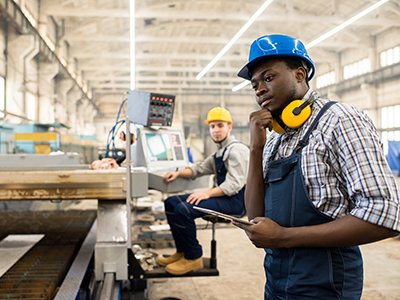As employees at one manufacturing plant returned to work after lockdowns, they started reporting more accidents than they used to.
When managers investigated, they came to a surprising conclusion: during the enforced time away, many employees had simply forgotten how to use their equipment safely.
As millions of people return to factories, offices, retail stores and other workplaces, occupational health is going to be more important than ever – and the risks are not always the obvious ones. So how should employers manage a safe return to work? What challenges and opportunities do they need to consider? And in an era of hybrid working, what even counts as a workplace?
Manage a safe return
“Do not rush. Take time to prepare,” says Ivan Ivanov, Head of Occupational and Workplace Health at the World Health Organization. “The virus may be with us for some time yet, so consider hybrid arrangements with some workers returning sooner than others.”
A slower, phased approach will also mean encouraging physical distancing, and recognizing that some working days are likely to be lost as people catch the virus or have contact with someone who has the virus and must isolate. It will also discourage employees from if returning to work means the risk is over.
In fact, our global research into health and safety at work finds that more than half (55%) of all employees have concerns regarding their health and safety at work or when they return to work.[1] And among blue collar workers, more than 40% are eager to receive a lot more information from their employer on the hygiene and cleanliness of the workplace (44%) and measures being taken to ensure employee safety (43%)[2].
The process by which workplace decisions are reached during this time will be crucial to their effectiveness. Most of the ways to stay safe as we return to work depend on cooperation from the workforce, so policies to encourage them will only be effective if employees are comfortable with them. The best way to achieve that is by involving employees in the process from the start.
“If you involve workers in the decision-making, the payoff in terms of trust will be enormous,” says Ivanov.
“But if you make decisions behind closed doors, and base them on business or logistical factors that employees don’t know about, the policies will probably lack legitimacy and be ineffective.” And bringing employees into the process means enabling them to raise concerns without being blamed.
Communication is a health issue
 The manufacturing plant that reported more accidents was not an isolated case. “Some collaborators lost their safety reflexes during the pandemic as operations stopped or slowed down,” says Philippe Casgrain, Global SVP for FM and HSE at Sodexo. “That’s why accidents may rise. So, we need to put much more emphasis on re-briefing people and giving them the right reminders and tools so they can operate safely.”
The manufacturing plant that reported more accidents was not an isolated case. “Some collaborators lost their safety reflexes during the pandemic as operations stopped or slowed down,” says Philippe Casgrain, Global SVP for FM and HSE at Sodexo. “That’s why accidents may rise. So, we need to put much more emphasis on re-briefing people and giving them the right reminders and tools so they can operate safely.”
As employees return to work, each person will have their own ideas about what is appropriate in terms of physical distancing, masks and disinfecting hands and surfaces. This will inevitably lead to some discomfort and disagreement. This is where clear policies will be vital: not only will they reduce the kind of workplace frictions that make organizations less effective, but they will also help to preserve trust and maintain engagement.
The clearer you can be, the better. For example, if masks are mandatory, does the rule apply in single-person offices as well as shared spaces?
Make mental health a priority
The pandemic has reminded us of the importance of mental health. Video conference fatigue, long hours working remotely, isolation from colleagues and the uncertainty associated with furlough schemes and economic insecurity all contribute to anxiety and burnout.
“The biggest thing companies can do is send a clear message that discussion of these issues is welcome,” says Ivanov. “You shouldn’t hesitate to contact your boss and say, ‘I am not feeling well’. It is okay not to be okay.”
The most progressive employers are proactive.
“Employers will need to adapt to make sure that the whole employee – personal and professional – is taken care of,” says Casgrain.
“I also experienced work-related burnout last November,” says Ivanov. “Fortunately, thanks to my training as a doctor, I had the expertise to pick it up quickly and sought professional help. Post-pandemic, employers should provide that support and show they care.”
Redefine the workplace
 Before the pandemic, it was clear what occupational health meant. But what does it mean now, when a growing proportion of employees no longer work in the same place? What is the remit of ‘occupational health’? Does it only apply in the location where employees work together, or in any location where work is carried out?
Before the pandemic, it was clear what occupational health meant. But what does it mean now, when a growing proportion of employees no longer work in the same place? What is the remit of ‘occupational health’? Does it only apply in the location where employees work together, or in any location where work is carried out?
“The definition of the workplace has to change,” says Ivanov. “We have to look at how employers can support workers when they're working from home or from anywhere.”
Understanding where your employees are is a precondition for understanding what they need to stay safe and healthy. Working at home can cause physical problems, for instance, where employees do not have the ergonomic set-up, they might have benefitted from in an office. “In my case,” says Casgrain, “I went to my doctor with a back problem. And she said the number of similar issues she has seen during the pandemic had just exploded.”
In response, some progressive companies are providing reimbursements to allow workers to adapt their home environments so they can work more efficiently and comfortably. That could be in the form of a bigger screen, a desk, and an ergonomic chair. “It could even mean moving to a bigger apartment with a dedicated workspace,” says Ivanov.
Ivanov does not expect employers to be thinking about that kind of assistance yet. The range of issues occupational health professionals might consider keeping their employees healthy is likely to stretch as teleworking becomes the new normal.
Prepare for future crises
“Once occupational health managers have managed the risks associated with traditional workplaces and the return to work, they should turn their attention to protocols for the future,” says Ivanov.
Just as fire drills remind employees that fire is a possibility and teach them how to react, companies should have a plan in place for when the next infectious disease breaks out. That might mean safety protocols, temperature checks and planning for a smooth transition to working from home.
And in an era that has dramatically illustrated the dependency between workplace health and businesses’ ability to turn a profit, occupational health amounts to a business-critical risk. Yet only 15% of workers worldwide work in organizations that provide professional occupational health services. Ivanov says that giving a named person, who has technical knowledge of basic occupational health, responsibility for occupational health is a good first step. “For smaller organizations, that person could be a consultant,” he says.
“Organizations are realizing that business continuity plans cannot just be about how to maintain production and services – they also have to be about how to make sure we don’t get sick,” says Ivanov. “This means that access to health expertise is now a critical success factor for all organizations. Occupational health for everyone everywhere will have to be the new normal.”
Does your workplace experience measure up? Download our report, Breathing Space: A New Workplace Comes to Life.
[1] Harris Tracker, Wave 4 Study – October 2020
[2] Ibid




